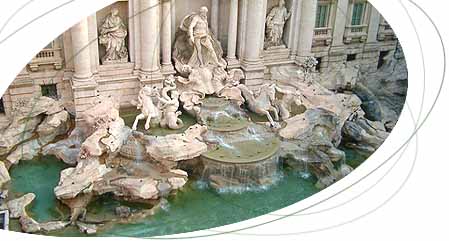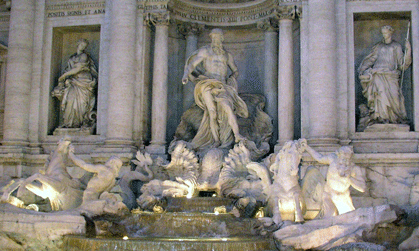

  |
The Trevi Fountain in Rome HotelThe Fontana di Trevi, or Trevi Fountain, may or may not be the most beautiful fountain in Rome but it certainly is the most famous. It is also the largest and most ambitious of the Baroque fountains in Rome. Known the world over as the fountain where Anita Ekberg cooled off at night in Federico Fellini's film La Dolce Vita, it is also known for the legend that holds that if you throw a coin over your shoulder into the fountain, your return to Rome will be ensured. Visit the Trevi Fountain and stay at Hotel Fontana: make your reservations now! » Located in the heart of Rome's historical center, the Trevi Fountain derives its name from its position at the intersection of three streets (tre vie). From here, it is just a short walk away from the Spanish Steps and its designer shopping area down Via Condotti, the Pantheon and Piazza Navona.  The Trevi Fountain also marks the terminal point of the Aqua Vergine, one of the ancient aqueducts that supplied water to Rome and which now supplies the fountain's water. In 19 BC, Roman technicians located a source of pure water, or virgin water, only 14 miles (22 km) from the city. This Aqua Virgo was carried over Rome's shortest aqueduct directly to the Baths of Agrippa and served Rome for more than four hundred years, up until the Goth besiegers broke the aqueducts. During the 15th century Renaissance, the Roman custom of building a fountain at the endpoint of an aqueduct that brought water to Rome was revived. In 1453, Pope Nicholas V Parentucelli finished mending the Aqua Vergine aqueduct and built a simple basin, designed by the humanist architect Leon Battista Alberti, to herald the water's arrival. In 1629, Pope Urban VIII Barberini found the earlier fountain insufficiently dramatic and asked Bernini to do some drawings for it. Bernini had the fountain's position moved from one side of the square to the other, in order that it faced the Quirinal Palace (so the Pope could look down and enjoy it too). The death of the Pope, however, soon brought work to a standstill and it was not until about a hundred years later that Clement XII entrusted the work to Nicola Salvi. Work began in 1732 and was finished in 1762. The theme of the gigantic scheme is the taming of the waters: tumbling forward, water and rockwork mixe together and fill the small square. The fountain is set against the back of the Palazzo Poli, which was given a new facade of Corinthian columns that link the two main stories. The Corinthian columns flank a triumphant arch with a large niche representing the palace of Neptune. Here in this central niche is Neptune, the sea god, riding a winged chariot guided by tritons through the gushing waters coming from the Acqua Vergine aqueduct. The chariot is drawn by winged steels and is led by a pair of tritons.
A smaller niche to the left of Neptune contains the statue of Abundance, spilling water from her urn, and above is a bas relief depicting Agrippa approving the plans for the Aqueduct. The niche on the right contains the figure of Salubrity holding a cup from which a snake is drinking and above, a relief of "Trivia", the Roman virgin, showing soldiers the Way. Salvi died in 1751 with his work half-finished. The Trevi Fountain was finished in 1762 by Giuseppe Pannini, who substituted the planned sculptures of Agrippa and Trivia with the bas reliefs. The fountain was refurbished in 1998; the stonework was scrubbed and the fountain provided with recirculating pumps and oxidizers. The Trevi Fountain is one of the worlds most photographed monuments in Rome,and many visitors agree that, among the many magnicent buildings of Baroque Rome, the Trevi Fountain is unrivalled as a spectacular aquatic structure. You can enjoy a spectacular view of the Trevi Fountain from right across the square, by staying at the Hotel Fontana during your visit to Rome. Dating back to the 13th century, the building originally served as a monastery and was only converted into a hotel during the late 1700's. Today, the Hotel Fontana welcomes guests with warm, family-style hospitality and offers elegance, charm and comfort. This central hotel in Rome offers guests a priviledged view of the Trevi Fountain's Baroque splendor, an opportunity to experience its magic from a viewpoint most visitors to Rome do not see. You can reach all of the major sites within minutes from the hotel. The charming Hotel Fontana works diligently to assure its guests a holiday experience of a lifetime... make your hotel reservations at the Trevi Fountain today! Make your reservations today at Hotel Fontana: |